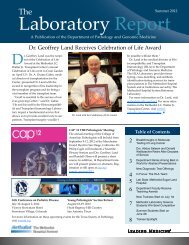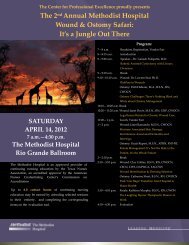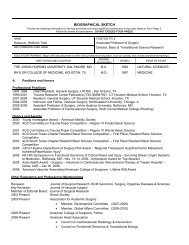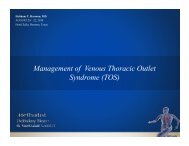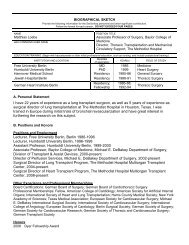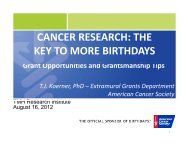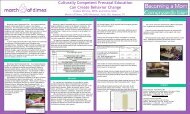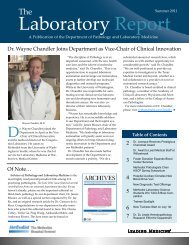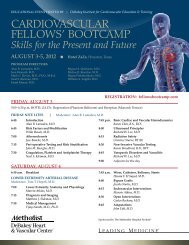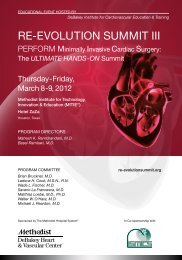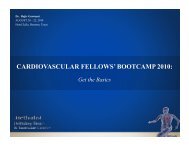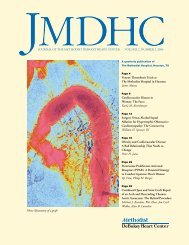DeBAKEy CARDIOvASCuLAR JOuRNAL - Methodist Hospital
DeBAKEy CARDIOvASCuLAR JOuRNAL - Methodist Hospital
DeBAKEy CARDIOvASCuLAR JOuRNAL - Methodist Hospital
Create successful ePaper yourself
Turn your PDF publications into a flip-book with our unique Google optimized e-Paper software.
sequences that offer superior signal-to-noise ratio in<br />
combination with whole-heart approaches analogous to<br />
multidetector CT. These sequences typically can be run<br />
with submillimeter in-plane spatial resolution (0.8–1.0<br />
mm) and slice thickness slightly more than 1 mm, and<br />
they generally require 10 minutes to perform. While<br />
this spatial resolution is insufficient to routinely assess<br />
for native vessel coronary stenosis, it is sufficient for<br />
identifying anomalous coronary arteries or coronary<br />
artery aneurysms.<br />
Stress testing with imaging of myocardial contraction<br />
can provide information concerning the presence and<br />
functional significance of coronary lesions. Dobutamine<br />
stress CMR to detect ischemia-induced wall motion<br />
abnormalities is an established technique for diagnosing<br />
coronary disease and is performed in a manner<br />
analogous to dobutamine echocardiography. It has been<br />
shown to yield higher diagnostic accuracy than dobutamine<br />
echocardiography 1 and can be effective in patients<br />
not suited for echocardiography because of poor acoustic<br />
windows. Logistic issues regarding patient safety<br />
and adequate monitoring are nontrivial matters that<br />
require thorough planning and experienced personnel.<br />
Stress perfusion CMR with adenosine has existed<br />
for nearly two decades with numerous clinical validation<br />
studies demonstrating average sensitivity and<br />
specificity of 84% and 80% respectively for detection of<br />
coronary stenosis in comparison to X-ray coronary angiography.<br />
2 These studies used various imaging protocols,<br />
and many used a quantitative approach for diagnostic<br />
assessment. Although a quantitative approach has the<br />
potential advantage of allowing absolute blood flow to<br />
be measured or parametric maps of perfusion to be generated,<br />
the approach is laborious and requires extensive<br />
interactive post-processing; this makes it unfeasible for<br />
everyday clinical use.<br />
Recently we have published a multicomponent<br />
approach to CMR stress testing that can generally be<br />
performed in less than one hour and includes the following:<br />
1) cine CMR for assessing cardiac morphology<br />
and regional and global systolic function at baseline, 2)<br />
stress perfusion CMR to visualize regions of myocardial<br />
hypoperfusion during vasodilation (e.g., with adenosine<br />
infusion), 3) rest perfusion CMR to aid in distinguishing<br />
true perfusion defects from image artifacts, and 4)<br />
DE-CMR for determining myocardial infarction. 3 We<br />
demonstrated that the determination of CAD using the<br />
multicomponent CMR stress test significantly improved<br />
diagnostic performance, yielding a sensitivity rate of<br />
89%, a specificity rate of 87%, and a diagnostic accurac<br />
rate of 88%.<br />
In conclusion, CMR is a useful imaging modality<br />
for detection of CAD. Coronary MRA approaches have<br />
demonstrated utility in assessment of coronary artery<br />
anomalies or aneurysms. Pharmacologic stress CMR<br />
(either of myocardial contraction or perfusion) is useful<br />
for detecting CAD or for determining the physiologic<br />
implication of stenosis of unclear significance detected<br />
on coronary angiography. CMR approaches offer several<br />
advantages over competing modalities in that they<br />
can generally be performed in less than an hour and do<br />
not require administration of ionizing radiation.<br />
References<br />
1. Nagel E, Lehmkuhl HB, Bocksch W, et al. Noninvasive<br />
diagnosis of ischemia-induced wall motion abnormalities<br />
with the use of high-dose dobutamine stress MRI:<br />
comparison with dobutamine stress echocardiography.<br />
Circulation. 1999 Feb 16;99(6):763–70.<br />
2. Shah DJ, Kim HW, Kim RJ. Evaluation of ischemic heart<br />
disease. Heart Fail Clin. 2009 Jul;5(3):315-32.<br />
3. Klem I, Heitner JF, Shah DJ, Sketch MH Jr, Behar v, Weinsaft<br />
J, Cawley P, Parker M, Elliott M, Judd RM, Kim RJ.<br />
Improved detection of coronary artery disease by stress<br />
perfusion cardiovascular magnetic resonance with the use<br />
of delayed enhancement infarction imaging. J Am Coll<br />
Cardiol. 2006 Apr 18;47(8):1630-8. Epub 2006 Mar 27.<br />
Appropriate Use Criteria (AUC) for<br />
Cardiovascular Imaging<br />
Raymond F. Stainback, M.D.<br />
Texas Heart Institute, Houston, Texas<br />
Cardiovascular (Cv) imaging use has increased substantially<br />
over the last 10 years. The reasons remain<br />
complex and partially defined. In 2005, the American<br />
College of Cardiology Foundation (ACCF) began a<br />
systematic process for determining imaging “appropriateness<br />
criteria,” now known as the “appropriate use<br />
criteria” (AuC). For each major Cv imaging modality,<br />
the modified Delphi Method was employed for determining<br />
AuC. 1 AuC were constructed using a three-step<br />
approach: 1) an expert writing group establishes a set<br />
of imaging and patient-specific “assumptions” along<br />
with a set of clinical scenarios (indications) for common<br />
anticipated uses; 2) external reviewers (other experts<br />
and stakeholders) critique the indications and suggest<br />
revisions; and 3) a diverse technical panel rates the<br />
clinical indications as appropriate (A), uncertain (u) or<br />
inappropriate (I) based on available published data and<br />
expert opinion. To date, initial and updated or in-progress<br />
AuC have been produced for cardiac radionuclide<br />
imaging (2005, 2009); echocardiography (2007, 2008,<br />
2010); cardiac computed tomography and MRI (2006,<br />
MDCvJ | vII (1) 2011 59



